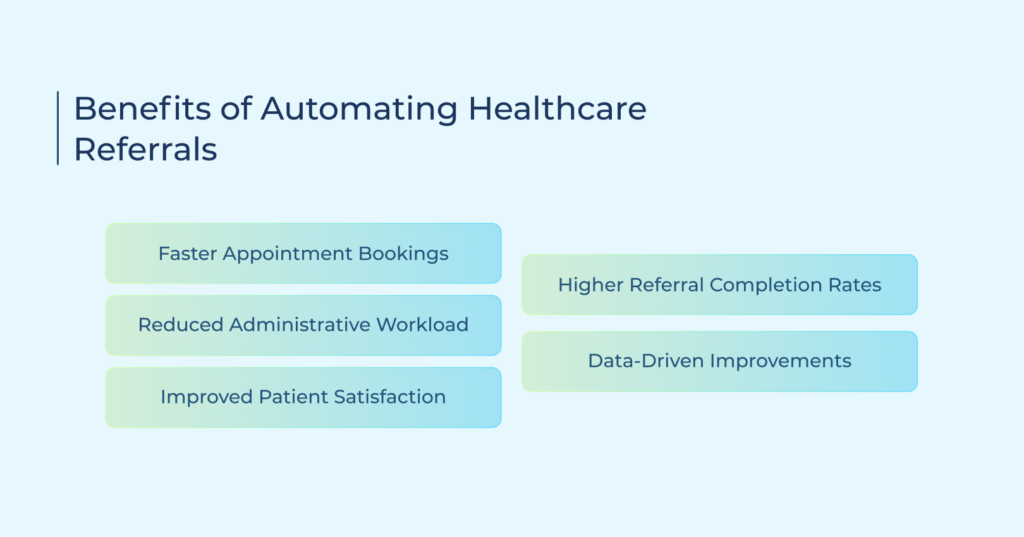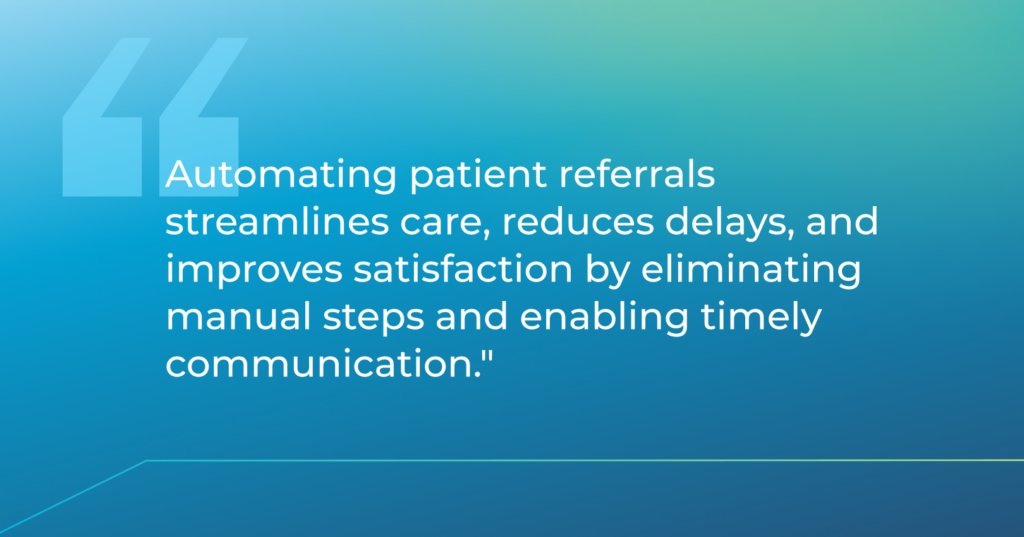Kamal Anand, chief product officer of TeleVox and Mosaicx, part of West Technology Group. In conversations across…

Improving Patient Healthcare Through Automated Patient Engagement
The patient referral process in healthcare can be tedious and inefficient. With procedural hoops to jump through and the back and forth of playing phone tag, referrals are often delayed or even missed.
Unsurprisingly, this pitfall can have a negative impact down the line in the patient’s care journey and bog down staff who are not providing quality patient care.
One solution to this growing issue is end-to-end, automated patient engagement technology. Recent advancements in this space mean the days of leaning on manual procedures to request and process patient referrals are gone.
Plus, consumers don’t want to pick up the phone, either. They’re used to handling daily tasks instantly and digitally, and seek to manage their healthcare in a similar fashion. This is why top hospitals and health systems are leveraging the latest technologies to offer patients digital healthcare communication options and give staff members tools to manage referrals in a streamlined, automated fashion.
Challenges of the Current Referral Process in Healthcare
While healthcare referrals are meant to send patients to specialists, the current process is known to create certain problems for providers and patients alike. These issues end up delaying care and often leave patients confused about their next steps.
Lack of Seamless Communication Across Care Teams
Since healthcare providers utilize various EHR systems that are incompatible with one another, staff have no choice but to manually transfer patient data to specialists. This is an ineffective communication process that tends to lose or delay important patient information. For instance, a recent test result might remain siloed in a separate system.
Hence, your specialists may lack access to your full medical history. This fragmentation leads to healthcare decisions that do not account for the patient’s complete medical condition.
Inadequate Patient Education on Referral Next Steps
Another common referral process challenge is educating patients on their next steps. It is likely that you yourself have sometimes left appointments without clear instructions about your referrals. This is mainly because the front desk staff failed to explain steps thoroughly due to a lack of time, or that the written instructions had too many complex medical terms. Additionally, patients may even receive too much information at once, causing them to confuse preparation requirements for different specialists.
No Standardization Across Referral Workflows
Every healthcare provider tends to create their own referral process. This means different forms for patients to fill out, different insurance and preparation requirements to meet, and different content channels to ask for information. Without a standardized process, inconsistent referral procedures make it impossible to ensure a smooth, coordinated experience for patients.
Administrative Burden on Staff
The healthcare referral system is known to place a significant administrative burden on its staff. Rather than dedicating their time to doing something useful for the patient, providers spend long hours calling up patients regarding appointments and insurance companies regarding verifications. They are also often tracking down missing records and dealing with overlapping scheduling calendars, all while performing their other administrative duties.
This manual, time-consuming process reduces operational efficiency while increasing the risk of errors, delays, and poor patient experiences.
Limited Visibility into Referral Status
It is difficult for primary healthcare providers to track the status of their patients’ referrals once they leave. While it ultimately depends on the systems in place, providers may not receive alerts if a patient’s insurance is denied or confirmations when specialists receive the referrals. This also means that if a patient misses their specialist appointment, referring doctors have no way of communicating back, leading to reduced patient health outcomes.
Poor Patient Experience and Engagement
The current referral process for healthcare providers can be frustrating for most patients because they have to wait weeks without any updates or are forced to make multiple phone calls for information. Without a centralized system, patients are repeatedly asked for their medical history at every new office. Some setups may even ask them to handle their insurance requirements themselves. The poor and often confusing patient engagement only ends up with missed appointments.
Reluctant Patients Due to Different Constraints
Many patients avoid completing referrals for numerous practical reasons. High costs not covered by insurance deter those with limited finances. Work schedules, especially for hourly employees who lose wages for appointments, create additional barriers.
Let’s not forget parents struggling to arrange childcare during medical visits or how past negative healthcare experiences leave patients hesitant to engage with new providers.
There are several other similar reasons and obstacles that play their parts in preventing patients from seeing specialists.
What Does an Automated Referral Process in Healthcare Look Like?
Consider consumer retail interactions: individuals can choose their preferred mode of communication, process actions via text, email, or live chat, and receive personalized follow-up. Much of this is done asynchronously. An automated, closed-loop referral process in healthcare is no different. It can streamline referral patient communications in much the same way
Consider consumer retail interactions: individuals can choose their preferred mode of communication, process actions via text, email, or live chat, and receive personalized follow-up. Much of this is done asynchronously. An automated, closed-loop referral process in healthcare is no different—
For example, Froedtert Health & the Medical College of Wisconsin implemented a closed-loop, automated referral management workflow that engaged patients via customized, automated SMS messaging or telephone calls.
Froedtert was able to engage approximately 1,800 contacts, turning a multi-week process into a three-day referral-to-appointment workflow. Based on this success, the organization expanded its campaign from just three departments to more than 30 specialties within a matter of weeks.
Healthcare organizations can build on this kind of success by automating their referral scheduling process through digitized, patient-centric communication. They will reach out to patients on time and through preferred channels (SMS, email, phone) as soon as a referral is ready to schedule. Patients can then connect directly with a registrar to set their appointment, avoiding long hold times or frustrating call transfers.
These automated workflows can also be integrated into the provider’s EHR systems, keeping patients, staff, and clinicians in the loop along the referral closure path. This automated, closed-loop referral management workflow can streamline patient interactions and ultimately improve referral closure rates.
To learn more about how your organization can revolutionize its referral management process, check out our latest article in Patient Engagement HIT here.
Benefits of Automating Healthcare Referrals
When healthcare organizations move from paper-based or disconnected referral systems to integrated digital solutions, they create measurable improvements across their operations. Here’s how:

- Faster Appointment Bookings: Patients are able to schedule their next appointment within hours instead of waiting days or weeks, cutting down the gap between diagnosis and treatment for faster health outcomes.
- Reduced Administrative Workload: Automation frees up employees to focus on patient care instead of answering phone calls and juggling paperwork.
- Improved Patient Satisfaction: Clear instructions, status updates, and easier scheduling give patients control over their healthcare journey.
- Higher Referral Completion Rates: More patients follow through with their specialist visits when their scheduling process is smooth and supported by timely digital reminders.
- Data-Driven Improvements: AI analytics continuously identify bottlenecks and service gaps in your referral process, making it easier for you to make targeted improvements.
Implementing an Automated Referral System: Best Practices
Moving from a manual to an automated referral process requires careful planning and execution. Such a systematic approach is the only way for healthcare organizations to address specific pain points while integrating new technology with existing systems.
Map Your Existing Referral Workflow
Start by documenting your current referral process. List down every department that becomes involved with a typical referral, which staff members handle what information, how documents are carried over, etc. Calculate the average time taken between each jump. This baseline assessment gives a clearer picture of what areas to improve and also stands as a KPI to measure success after implementation.
Identify Key Integration Points with Your EHR and Systems
There’s no point in an automated referral system if it can’t work with your existing technology. Check software requirements and reach out to vendors to confirm compatibility. Additionally, note down where parts of your process need to be automated. This can include insurance verification, updating patient information, contacting patients, managing scheduling calendars, analysing reports, and such.
Choose a Scalable and HIPAA-Compliant Technology Partner
Automation gives healthcare organizations room to grow, which requires your new technology to be highly scalable. It’s not just about handling peak patient volumes or emergency situations, but also about efficiently scaling down during slower periods. That’s why it’s both a smart and strategic move to invest in scalable automated referral systems. This ensures you won’t need to reinvest later to keep up with increasing demand.
It’s also equally important to select technology that complies with all HIPAA standards. This is to boost your security measures and safeguard sensitive patient information. Data breaches can severely damage a healthcare organization’s credibility and trust with patients, so always ensure that any system you adopt is fully capable of securing all communications.
Automating the Workflows
For the next step in implementing an automated referral system, healthcare organizations must build and test their new digital processes before full implementation. Start with one department or a small specialty to confirm everything is working as intended.
In the best-case scenario, you will only have to make a few minor adjustments to your pilot program.
In the worst-case scenario, an incorrect setup could disrupt the provider’s entire workflow, such as by creating duplicate entries or routing information to the wrong departments. Testing early allows you to identify and resolve these issues before they impact patient care.
Staff Training and Adoption
Your staff has to be properly trained to effectively use the new system. Conduct regular workshops and role-specific training programs to ensure everyone at every level is familiar and comfortable using the new processes.
It’s also good practice to gather feedback from your staff because they are the ones using the new system on a daily basis. Their feedback might help improve a critical node that could potentially create a bottleneck down the road.
Track Key Metrics to Measure the Effectiveness
To determine if your automated referral system works, collect and analyze key performance data regularly. Compare how many patients complete referrals now versus before automation, and measure how much faster patients secure appointments.
Track the time staff spend managing referrals to confirm the system reduces their workload. Survey patients about their experience with the new process to identify satisfaction improvements. Count incoming phone calls and manual paperwork to quantify administrative reductions.
Reviewing these metrics on a scheduled basis helps healthcare organizations maximize the effectiveness of their automated systems. This includes maximizing ROI as well.

Close the Loop and Improve Your Healthcare Referral Process With TeleVox
Take control of your referral workflow with TeleVox, a powerful patient engagement platform designed to close the loop and eliminate referral leakage through smart automation.
Our next-generation AI-powered SMART Agent ensures no referral falls through the cracks by delivering timely, personalized communication through patients’ preferred channels. SMART Agent acts as a 24/7 virtual concierge, seamlessly connecting with patients via phone, text, or chat to guide them through every step of their referral journey.
From automated appointment reminders and real-time status updates to seamless integration with your EHR, TeleVox meets patients where they are, and that too without overburdening your staff.
Ready to reduce referral leakage, improve operational efficiency, and give patients the seamless experience they expect? Schedule a demo today and discover how TeleVox and our HIPAA-compliant tech can help.



